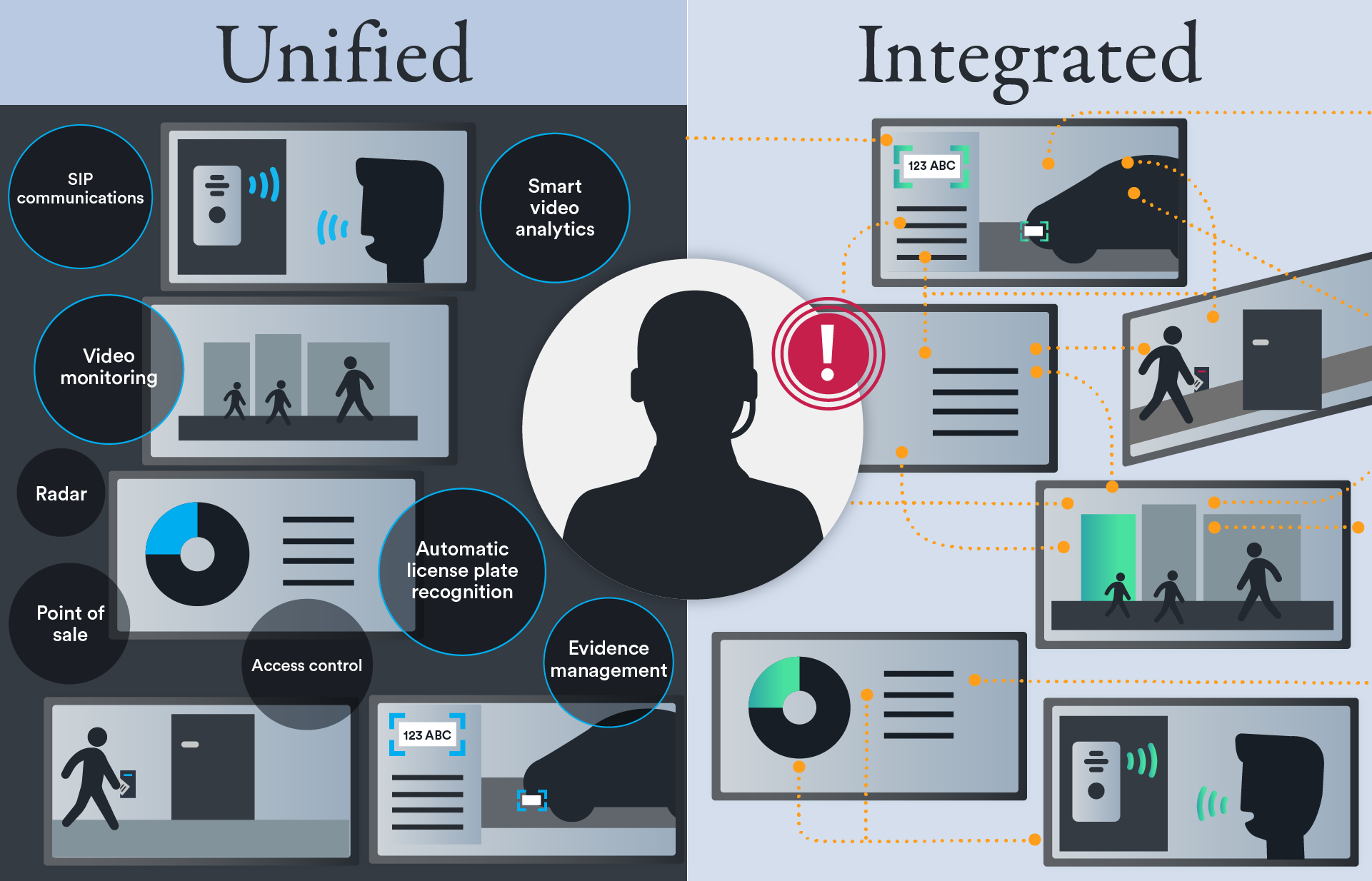Unified vs. integrated physical security solutions
Explore the differences between a unified and integrated physical security system. And learn why integration with a unification approach is a must.

Unification isn’t just about the technology. It’s about alignment. It’s an organizational approach that allows businesses to standardize processes and streamline data sharing across departments. Beyond systems and data, a unified solution brings great minds together. It provides a foundation for limitless expansion and new ways of working.
Consider this—if you can unify all your systems, sites, processes, and teams, what outcomes could you generate across your business? Unification at that level can lead to huge time and cost savings, stronger collaboration, and better business insights.
GUIDE
What is a unified physical security solution?
Unification is the process of being united or made into a whole. A unified physical security platform consists of a suite of products from one or multiple vendors which are deeply interconnected. This allows for ease and flow of information within a single pane of glass that enables faster, more informed decision-making across all operator activities. These products can include systems such as video surveillance, access control, automatic license plate recognition, intrusion, intercom, Industrial Internet of Things (IIoT), and much more.
Having a unified physical security solution means you can turn these different systems on or off, but you can't break connections, because there aren't any. A unified solution consolidates all of the data that you gather and displays it in one intuitive application. This allows operators to easily monitor security across your premises because no matter what type of data that comes in, they’re getting a comprehensive picture of what’s happening.
By having everything in one place, operators can be more efficient and confident. They'll have more control when managing security policies, responding to events, running investigations, and handling cybersecurity and maintenance.
The differences between unified and integrated systems
The terms unification and integration are often used interchangeably, but they don't mean the same thing.
Integration is the result of combining one thing with another. An integrated physical security platform is made up of connections. Different, independent security solutions from various vendors are linked together using a software development kit (SDK) or application programming interface (API). Some system capabilities will be accessible from one or many solutions, but they may be limited to very specific features and tasks.
The challenge is that if one connection breaks, it can affect all the others. The more connections you have when joining one system to another, the more costly and complicated upgrades and maintenance become.

TECHNICAL COMPARISON
Having different vendor solutions means more training, servers, and maintenance. It’ll also take a lot more time and effort to consolidate large amounts of data from all these independent systems. This can slow incident response and investigations and increase operator overwhelm.
4 ways to capitalize on both unification and integration
Yes, integrated systems can complement unified security systems. But this requires investing in the right foundation from the start. Here are a few important considerations that can help you capitalize on both unification and integration.
 |
Strong integrations happen with strong vendor collaboration |
Did you know that there are varying levels of integrations? Some integrations between different systems are very basic and offer very limited cross-system functionality and compatibility. In other cases, technology vendors come together to ensure there’s a greater depth and strength between integrated solutions.
This level of collaboration between technology partners ensures you get a more fluid and functional experience. It’ll allow you to access all critical system data and capabilities. Beyond that, you’ll even be able to generate comprehensive reports, configure devices, monitor system health status, and more. And when upgrades happen, you’ll experience a smoother process and more collaborative vendor support.
BLOG
 |
Open architecture platforms allow for broader integrations |
A unified security platform can be built on a closed, proprietary architecture, or an open, non-proprietary architecture. A closed system locks you into a single vendor’s technology, limiting your integration options.
An open, unified platform gives you the freedom to choose from an expansive list of technology partners and solutions. You can even customize and build connections to existing devices and systems, expanding the scope of functionality and data available within your unified platform.
Integration can be complementary to unification. But to achieve that, you need strong integrations within a rich, open, and unified platform to extract the most value from your investments.
 |
Integrations beyond physical security add significant value |
Unification isn’t limited to physical security. With an open, unified platform, there’s an opportunity to gain meaningful business insights and expand operational value. This can be done by adding integrations to various building and business systems, or IIoT sensors.
That alone isn’t enough. How can people within your organization truly capitalize on these business connections and cultivate that unification approach?
Choosing easy-to-use solutions that can support secure, limited-use applications for people outside of the security department is a must. Having a unified platform that offers rich data visualization is also important. It can display data in maps, charts, or histograms, rather than in databases and spreadsheets. These core features can help various people and groups get their work done faster, while also uncovering opportunities for business improvements along the way.
For instance, IT and SecOps teams can get standardized data formats, providing consistent paths to extract and export information to external databases or data lakes. A data-driven view can also help teams optimize space, streamline parking, expand sustainability efforts, or comply with industry requirements. Another option is to extend system information to other departments that are focused on improving the customer experience or business services.
BLOG
 |
Stay flexible and adaptable |
A decade ago, having a unified physical security system meant that your video management solution and access control system worked together to enable visual verification of access control events. Since then, the number of different security applications and sensors that organizations use to secure their environments has exploded.
Everything from AI-powered video analytics, SIP communications, and ALPR to point of sale, radar, and IIoT sensors are being unified in one platform. Things are changing quickly too. With that, organizations want to expand, adapt, and modernize systems with greater agility.
A unified security platform built on an open architecture and with an expansive ecosystem of partners offers you the most flexibility. It helps your organization grow beyond physical security to establish a more productive and collaborative experience overall. It’s a long-term investment with the potential to optimize the ways your people work, think, and bring value to your organization.
